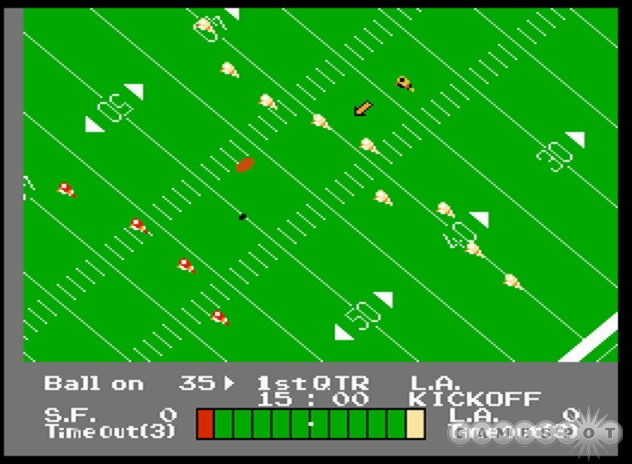Sports games are typically rendered obsolete six months to a year after their initial release. However, there are exceptions: Those rare instances when a game is so scrumptiously good that it begs to be played despite the roster being outdated or the graphics going out of style. Sadly, NES Play Action Football is not one of those exceptions. It was weak when it was originally published for the Nintendo Entertainment System back in 1990 and seems even more ridiculous now that it's available for the Wii's Virtual Console.
Tecmo Bowl, which came out a year before NES Play Action Football, offered players the entire slate of real NFL teams, a season mode, and a playbook containing dozens of authentic NFL plays. By contrast, NES Play Action Football serves up eight fictional teams, an abbreviated playoffs mode, and 24 offensive plays. That lack of content isn't so bad when you realize that Nintendo was clearly aiming to court people looking for a more easygoing, arcade-style take on the gridiron. Every pass looks like a Hail Mary and running plays usually result in 20-yard gains if you get past the defensive line. The basic controls make it easy to run, pass, and tackle as needed. You can tap the run button to give your receiver a burst of speed, but beware: It'll tire him out quicker and force you to make a substitution sooner. There aren't any audibles or defensive jukes to worry about. Instead, you simply have to avoid the defenders that try to get close when you're on offense and press the tackle button when you're on defense.

There's nothing inherently wrong with a sports game that combines easygoing controls with an over-the-top approach. It certainly worked for NBA Jam and NFL Blitz, but the problem with NES Play Action Football is that the on-field action doesn't convey the necessary bursts of excitement. Playing against the CPU is no fun because it repeats the same lines and plays on offense. It also doesn't bother to challenge you on defense until you reach the 30-yard-line, when the computer instantly transforms into an unstoppable super-team like the 1985 Chicago Bears. Even if you manage to get a game going with one, two, or three of your friends, you'll still have to contend with how slowly the players move. They're like turtles out there. Waiting for receivers to get into position and watching them gradually move the ball up the field is excruciating. Tapping the run button also doesn't speed them up very much.
As for the graphics and audio, they're pretty lifeless too. The field has no detail apart from the necessary lines and boundary markings. The players, viewed from above, all look like the same amorphous blob with a round head and a larger rounded body. There isn't much animation to speak of because running consists of two jerky frames, while a passer simply holds his arm out straight when throwing the ball. Dives, kneel downs, and tackles all employ the same arms-out-Superman-flying animation. The only graphical highlight is that you're treated to a cutscene whenever you sack the QB or score a touchdown. Audio consists primarily of crude ticks and tones. The digitized referee speech clips are impressive for a NES game, but even then, you have to turn the volume up pretty high to hear them clearly.
Basically, there's absolutely no compelling reason for you to waste 500 Wii points ($5) on NES Play Action Football. When it first came out, it was already behind Tecmo Bowl in every aspect (depth, fun, graphics, audio), and the dumb CPU along with the sluggish players didn't help matters any. Playing the game today, it comes across like a museum piece that's only meant to remind us just how good Tecmo Bowl and the early John Madden games were years ago.